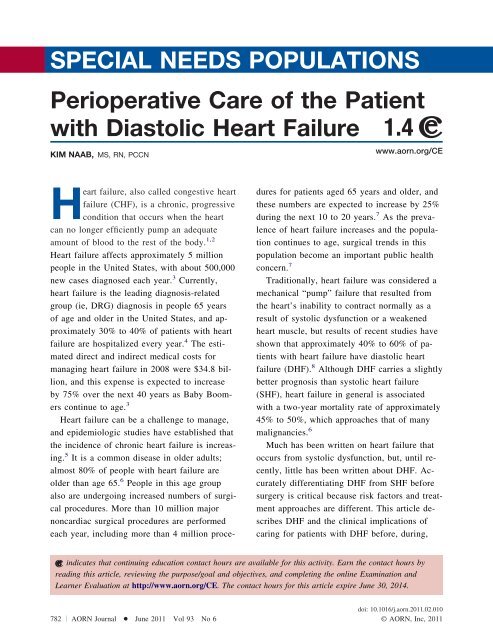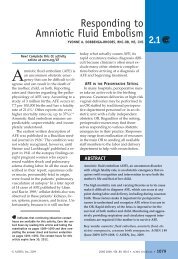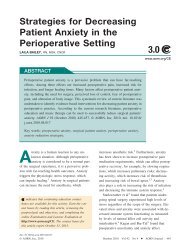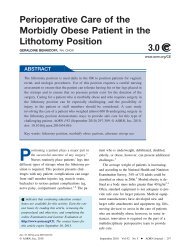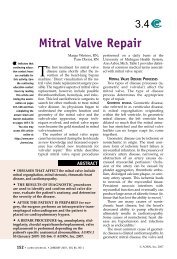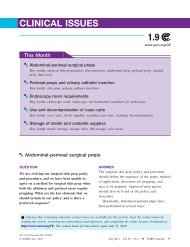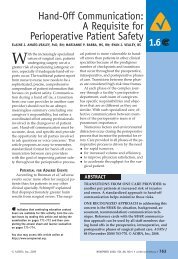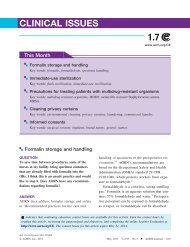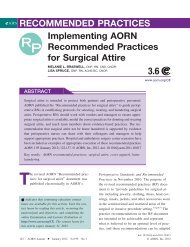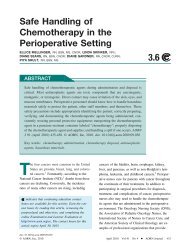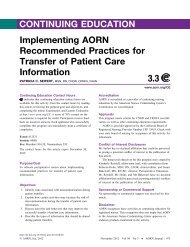Perioperative Care of the Patient with Diastolic Heart Failure ... - AORN
Perioperative Care of the Patient with Diastolic Heart Failure ... - AORN
Perioperative Care of the Patient with Diastolic Heart Failure ... - AORN
Create successful ePaper yourself
Turn your PDF publications into a flip-book with our unique Google optimized e-Paper software.
June 2011 Vol 93 No 6 NAABTABLE 1. Symptoms <strong>of</strong> <strong>Diastolic</strong> <strong>Heart</strong> <strong>Failure</strong> 1Right-sided diastolic heart failure Ascites (ie, excess peritoneal fluid) Congestion <strong>of</strong> <strong>the</strong> gastrointestinal tract that results inweight loss Hepatomegaly (ie, enlargement <strong>of</strong> <strong>the</strong> liver) Impaired liver function Increased jugular venous pressure Peripheral edema Presence <strong>of</strong> a parasternal heave, which indicatescompensatory increase in contraction strengthLeft-sided diastolic heart failure Cyanosis, which suggests hypoxemia Dullness in lung fields to finger percussion Increased work <strong>of</strong> breathing Pleural effusion detectable by reduced breath sounds at <strong>the</strong>bases <strong>of</strong> <strong>the</strong> lungs Pulmonary edema Rales or crackles initially heard in lung bases but, whensevere, are heard throughout <strong>the</strong> lung fields Tachypnea (ie, increased respiratory rate)1. Pierce JD, Dalton K, Duke K, Spaniol JR. <strong>Heart</strong> failure guidelines and implications for surgically treating heart failure. <strong>AORN</strong> J. 2009;90(6):874-892.increase abnormally during exercise, <strong>with</strong> reducedexercise tolerance. When left ventricularfilling pressures increase fur<strong>the</strong>r, <strong>the</strong> left atrialpressure and size increase and exercise tolerancedecreases <strong>with</strong> clinical signs <strong>of</strong> CHF. Thefundamental problem in DHF is <strong>the</strong> inability <strong>of</strong><strong>the</strong> left ventricle to accommodate blood volumeduring diastole at normal filling pressures. 14Abnormalities associated <strong>with</strong> DHF includeslow and delayed relaxation and increasedchamber stiffness, which impairs filling anddecreases <strong>the</strong> ability <strong>of</strong> <strong>the</strong> heart to eject bloodproperly. 15 Resting left ventricular stiffness is<strong>the</strong> resistance to stretch that occurs to counterhigh systolic pressures. 16 Three conditions mustbe present to confirm DHF: first, CHF symptoms must be detected; second, <strong>the</strong>re must be preserved systolic functionnoted <strong>with</strong>in <strong>the</strong> first 72 hours after CHFsymptoms are detected; and third, <strong>the</strong>re must be diastolic dysfunction. 17EtiologyThe most common causes <strong>of</strong> systolic dysfunctionare ischemic heart disease, idiopathic dilatedcardiomyopathy, hypertension, and valvularheart disease, whereas <strong>the</strong> most commoncauses <strong>of</strong> diastolic dysfunction are ischemicheart disease, hypertrophic and restrictive cardiomyopathies,and hypertension. 6 Risk factorsfor DHF include aging, being female, hypertension,increased left ventricular mass, diabetes,obesity, and ischemic heart disease. 18SymptomsThe symptoms <strong>of</strong> DHF are very similar to those<strong>of</strong> SHF, and it is almost impossible to clinicallydifferentiate between <strong>the</strong> two <strong>with</strong>out echocardiography.12 The difference in symptoms,which depends on <strong>the</strong> side <strong>of</strong> <strong>the</strong> heart involvedin DHF, are shown in Table 1. 19 It is importantto note that DHF is seen more <strong>of</strong>ten in elderlywomen <strong>with</strong> a long-standing history <strong>of</strong> hypertension.The first symptom is usually exerciseintolerance, <strong>with</strong> shortness <strong>of</strong> breath, both <strong>of</strong>which are also seen in SHF.SURGICAL CONSIDERATIONSResults <strong>of</strong> previous studies have found tha<strong>the</strong>art failure confers a significant risk <strong>of</strong> morbidityand mortality after noncardiac surgery.7,20,21 <strong>Heart</strong> failure is present in almost20% <strong>of</strong> cases <strong>of</strong> common surgical proceduresperformed in elderly patients, and <strong>the</strong>se patientshave a 63% greater risk <strong>of</strong> surgical mortalityand a 51% greater risk <strong>of</strong> a 30-day, all-causereadmission among patients <strong>with</strong> heart failurecompared <strong>with</strong> patients who do not have heartfailure or coronary artery disease. 7 For morethan three decades, <strong>the</strong> presence <strong>of</strong> signs and784 <strong>AORN</strong> Journal
SPECIAL NEEDS POPULATIONSwww.aornjournal.orgThe nurse works <strong>with</strong> <strong>the</strong> surgeon and anes<strong>the</strong>siapr<strong>of</strong>essional to correct any reversible predisposingfactors before surgery. 18Intraoperative Nursing <strong>Care</strong>The key to managing a patient <strong>with</strong> DHF duringand after surgery is to maintain preoperativeparameters as closely as possible. 18 Awareness on<strong>the</strong> nurse’s part <strong>of</strong> a patient’s increased risks forlow cardiac output and pulmonary venous congestionwill help to ensure that all precautions aretaken. Depending on <strong>the</strong> severity <strong>of</strong> <strong>the</strong> heart failure,many patients are unable to lie flat to sleep,and a patient <strong>with</strong> heart failure, <strong>the</strong>refore, maynot be able to tolerate being in <strong>the</strong> supine positionon <strong>the</strong> OR bed. The nurse works <strong>with</strong> <strong>the</strong> anes<strong>the</strong>siapr<strong>of</strong>essional to enable <strong>the</strong> patient to remainin <strong>the</strong> lawn chair position during induction if atall possible. 19The nurse also must be aware that <strong>the</strong> adverseeffects <strong>of</strong> inadvertent perioperative hypo<strong>the</strong>rmiaon wound healing are even more significantfor patients <strong>with</strong> heart failure who alreadyhave a compromised cardiovascular system. 19Initiating <strong>the</strong>rmoregulatory measures for patientsundergoing heart failure interventions,<strong>the</strong>refore, is extremely important. <strong>Patient</strong>sshould undergo preoperative warming (eg,forced-air warming, warmed IV solutions), and<strong>the</strong>se interventions should be continued in <strong>the</strong>OR and during recovery. 19Postoperative Nursing <strong>Care</strong>The postanes<strong>the</strong>sia care unit nurse closely monitors<strong>the</strong> patient’s vital signs, respiratory status,heart rhythm, and intake and output for signsand symptoms <strong>of</strong> fluid overload. <strong>Patient</strong>s <strong>with</strong> ahistory <strong>of</strong> DHF are at an increased risk <strong>of</strong> atrialfibrillation as a result <strong>of</strong> ventricular stiffnessand higher end-diastolic pressures. 9 The nurseshould monitor <strong>the</strong> patient’s heart rate andrhythm before, during, and after surgery, andshould instruct <strong>the</strong> patient to alert <strong>the</strong> nurse ifhe or she experiences chest pain, discomfort,tightness, or any difficulty breathing. The nurseshould continue to monitor <strong>the</strong> patient’s vitalsigns according to hospital policy in addition tomonitoring respiratory status, pain level, andsigns <strong>of</strong> fluid volume overload.Assessing for nausea and pain is very importantin <strong>the</strong> postoperative period, and <strong>the</strong> nursemust understand which pain medications shouldbe avoided in patients <strong>with</strong> a history <strong>of</strong> heart failure.Results <strong>of</strong> recent studies have shown thatpatients <strong>with</strong> a history <strong>of</strong> heart failure shouldavoid nonsteroidal anti-inflammatory drugs(NSAIDs) for analgesia. 23,24 Certain medications,such as NSAIDs, inhibit prostaglandin syn<strong>the</strong>sis,which causes a decrease in renal blood flow andcompensatory water and sodium retention. Prostaglandindepletion directly increases vascular resistance,thus worsening <strong>the</strong> patient’s hemodynamicstatus. 23 The nurse should also instruct <strong>the</strong> patientnot to use NSAIDs at home for pain managementunless this is approved by <strong>the</strong> physician.CONCLUSION<strong>Heart</strong> failure places a major economic burden onsociety, and those who have it lead a decreasedquality <strong>of</strong> life. As <strong>the</strong> population continues to ageand older adults undergo more surgical procedures,perioperative nurses must have an understanding<strong>of</strong> <strong>the</strong> different types <strong>of</strong> heart failure and<strong>the</strong> differences in treatment and management <strong>of</strong>each type. <strong>Patient</strong>s <strong>with</strong> a history <strong>of</strong> DHF have anincrease risk <strong>of</strong> surgical complications and adversesurgical outcomes. Applying sound nursinginterventions throughout <strong>the</strong> perioperative periodwill help to decrease postoperative complicationsand improve patient outcomes.References1. About heart failure. American <strong>Heart</strong> Association. http://www.heart.org/HEARTORG/Conditions/<strong>Heart</strong><strong>Failure</strong>/About<strong>Heart</strong><strong>Failure</strong>/About-<strong>Heart</strong>-<strong>Failure</strong>_UCM_002044_Article.jsp. Accessed February 24, 2011.2. <strong>Heart</strong> failure. MedlinePlus. http://www.nlm.nih.gov/medlineplus/ency/article/000158.htm. Accessed February24, 2011.3. Allman E, Berry D, Nasir L. Depression and coping inheart failure patients: a review <strong>of</strong> <strong>the</strong> literature. J CardiovascNurs. 2009;24(2):106-117.<strong>AORN</strong> Journal 787
June 2011 Vol 93 No 6 NAAB4. Grossman S, Brown D. Congestive heart failure and pulmonaryedema. Emedicine. http://emedicine.medscape.com/article/757999-overview. Accessed February 24,2011.5. De Keulenaer G, Brutsaert D. Systolic and diastolicheat failure: different phenotypes <strong>of</strong> <strong>the</strong> same disease?Eur J <strong>Heart</strong> Fail. 2007;9(2):136-143.6. Figueroa MS, Peters JI. Congestive heart failure: diagnosis,pathophysiology, <strong>the</strong>rapy, and implications forrespiratory care. Respir <strong>Care</strong>. 2006;51(4):403-412.7. Hammill BG, Curtis LH, Bennett-Guerrero E, et al.Impact <strong>of</strong> heart failure on patients undergoing majornoncardiac surgery. Anes<strong>the</strong>siology. 2008;108(4):559-567.8. Satpathy C, Mishra T, Satpathy R, Satpathy H, BaroneE. Diagnosis and management <strong>of</strong> diastolic dysfunctionand heart failure. Am Fam Physician. 2006;73(5):841-846.9. Gutierrez C, Blanchard DG. <strong>Diastolic</strong> heart failure:challenges <strong>of</strong> diagnosis and treatment. Am Fam Physician.2004;69(11):2609-2616.10. Chatterjee K, Massie B. Systolic and diastolic heartfailure: differences and similarities. J Card Fail. 2007;13(7):569-576.11. White MM, Howie-Esquivel J, Caldwell MA. Improvingheart failure symptom recognition: a diary analysis.J Cardiovasc Nurs. 2010;25(1):7-12.12. Wu EB, Yu CM. Management <strong>of</strong> diastolic heartfailure—a practical review <strong>of</strong> pathophysiology andtreatment trial data. Int J Clin Pract. 2005;59(10):1239-1246.13. Groban L, Kitzman DW. <strong>Diastolic</strong> function: a barometerfor cardiovascular risk? Anes<strong>the</strong>siology. 2010;112(6):1303-1306.14. Feld Y, Dubi S, Reisner Y, Schwammenthal E, ElamiA. Future strategies for <strong>the</strong> treatment <strong>of</strong> diastolic heartfailure. Acute Card <strong>Care</strong>. 2006;8(1):13-20.15. Redderson LA, Keen C, Nasir L, Berry D. <strong>Diastolic</strong>heart failure: state <strong>of</strong> <strong>the</strong> science on best treatmentpractices. J Am Acad Nurse Pract. 2008;20(10):506-514.16. Hamlin SK, Villars PS, Kanusky JT, Shaw AD. Role <strong>of</strong>diastole in left ventricular function, II: diagnosis andtreatment. Am J Crit <strong>Care</strong>. 2004;13(6):453-468.17. Sürücü H, Tatli E, Değirmenci A, Okudan S, Boz H.Subtle systolic dysfunction may be associated <strong>with</strong> <strong>the</strong>tendency to develop diastolic heart failure in patients<strong>with</strong> preserved left ventricular ejection fraction. Echocardiography.2009;26(4):365-370.18. Alsaddique AA, Royse AG, Royse CF, Fouda MA.Management <strong>of</strong> diastolic heart failure following cardiacsurgery. Eur J Cardiothoracic Surg. 2009;35(2):241-249.19. Pierce JD, Dalton K, Duke K, Spaniol JR. <strong>Heart</strong> failureguidelines and implications for surgically treating heartfailure. <strong>AORN</strong> J. 2009;90(6):874-892.20. Hernandez AF, Newby LK, O’Connor CM. Preoperativeevaluation for major noncardiac surgery: focusingon heart failure. Arch Intern Med. 2004;164(16):1729-1736.21. Hernandez AF, Whellan DJ, Stroud S, Sun JL,O’Conner CM, Jollis JG. Outcomes in heart failure patientsafter major noncardiac surgery. J Am Coll Cardiol.2004;44(7):1446-1453.22. Fleisher LA. Implications <strong>of</strong> preoperative heart failure:<strong>the</strong> next frontier in perioperative medicine? Anes<strong>the</strong>siology.2008;108(4):551-552.23. Dal Corso E, Bondiary AL, Zanolla L, Vassanelli C.Nurse educational activity on non-prescription <strong>the</strong>rapiesin patients <strong>with</strong> chronic heart failure. Eur J CardiovascNurs. 2007;6(4):314-320.24. Feenstra J, Heerdink ER, Grobbee DE, Stricker BH.Association <strong>of</strong> nonsteroidal anti-inflammatory drugs<strong>with</strong> first occurrence <strong>of</strong> heart failure and <strong>with</strong> relapsingheart failure: <strong>the</strong> Rotterdam Study. Arch Intern Med.2002;162(3):265-270.Kim Naab, MS, RN, PCCN, is a cardiac interventionstaff nurse at Piedmont Hospital,Atlanta, GA. Ms Naab has no declared affiliationthat could be perceived as posing apotential conflict <strong>of</strong> interest in <strong>the</strong> publication<strong>of</strong> this article.788 <strong>AORN</strong> Journal
EXAMINATIONCONTINUING EDUCATION PROGRAM<strong>Perioperative</strong> <strong>Care</strong> <strong>of</strong> <strong>the</strong> <strong>Patient</strong>With <strong>Diastolic</strong> <strong>Heart</strong> <strong>Failure</strong>1.4www.aorn.org/CEPURPOSE/GOALTo educate perioperative nurses about caring for patients <strong>with</strong> diastolic heart failure(DHF) who are undergoing surgery.OBJECTIVES1. Discuss <strong>the</strong> pathophysiology <strong>of</strong> DHF.2. Describe <strong>the</strong> etiology <strong>of</strong> DHF.3. Identify underlying disorders associated <strong>with</strong> <strong>the</strong> development <strong>of</strong> DHF.4. Describe perioperative management <strong>of</strong> <strong>the</strong> patient <strong>with</strong> DHF.5. Differentiate between symptoms <strong>of</strong> DHF and systolic heart failure.The Examination and Learner Evaluation are printed here for your convenience.To receive continuing education credit, you must complete <strong>the</strong> Examination andLearner Evaluation online at http://www.aorn.org/CE.QUESTIONS1. Almost ______ <strong>of</strong> people <strong>with</strong> heart failure areolder than 65 years <strong>of</strong> age.a. 50% b. 60%c. 70% d. 80%2. A condition that interferes <strong>with</strong> <strong>the</strong> heart’s abilityto relax is classified asa. diastolic heart dysfunction.b. systolic heart dysfunction.3. <strong>Diastolic</strong> dysfunction and DHF are interchangeableterms that refer to a preclinical state thatinvolves abnormalities in cardiac filling.a. true b. false4. Abnormalities associated <strong>with</strong> DHF include <strong>the</strong>following:a. delayed relaxation and increased chamberstiffness.b. high systolic pressures and low diastolicpressures.c. low systolic pressures and high diastolicpressures.d. normal relaxation and decreased chamberstiffness.5. To confirm DHF, conditions that must be presentinclude1. congestive heart failure symptoms.2. diastolic dysfunction.3. systolic dysfunction.4. preserved systolic function.a. 1 and 2 b. 3 and 4c. 1, 2, and 4 d. 2, 3, and 4© <strong>AORN</strong>, Inc, 2011 June 2011 Vol 93 No 6 ● <strong>AORN</strong> Journal 789
June 2011 Vol 93 No 6 CE EXAMINATION6. Common causes <strong>of</strong> DHF include1. ischemic heart disease.2. hypertension.3. hypertrophic cardiomyopathy.4. pericarditis.5. restrictive cardiomyopathy.6. valvular heart disease.a. 1, 3, and 5 b. 2, 4, and 6c. 1, 2, 3, and 5 d. 1, 2, 3, 4, 5, and 67. The symptom <strong>of</strong> DHF that usually is noted first isa. ankle and leg edema.b. dizziness or ligh<strong>the</strong>adedness.c. exercise intolerance <strong>with</strong> shortness <strong>of</strong> breath.d. whole body edema.8. _____________________________ should beaggressively treated before surgery to reduce <strong>the</strong>risk <strong>of</strong> perioperative heart failure.a. Atrial fibrillationb. Hypertensionc. Activity intoleranced. Chronic renal insufficiency9. <strong>Perioperative</strong> nurses must be prepared to helppromote positive surgical outcomes for a patientwho already has a compromised cardiovascularsystem by1. positioning <strong>the</strong> patient in <strong>the</strong> lawn chair positionduring induction if at all possible.2. initiating <strong>the</strong>rmoregulatory measures beforesurgery.3. maintaining preoperative parameters as closelyas possible.4. maintaining <strong>the</strong>rmoregulatory interventions in<strong>the</strong> OR and during recovery.a. 1 and 2b. 1, 3, and 4c. 2, 3, and 4d. 1, 2, 3, and 410. <strong>Patient</strong>s <strong>with</strong> a history <strong>of</strong> heart failure shouldavoid nonsteroidal anti-inflammatory drugs because<strong>the</strong>y1. cause a decrease in renal blood flow.2. increase vascular resistance.3. inhibit prostaglandin syn<strong>the</strong>sis.4. worsen <strong>the</strong> patient’s hemodynamic status.a. 1 and 3b. 2 and 4c. 1, 2, and 4d. 1, 2, 3, and 4The behavioral objectives and examination for this program were prepared by Rebecca Holm, MSN, RN, CNOR, clinical editor,<strong>with</strong> consultation from Susan Bakewell, MS, RN-BC, director, Center for <strong>Perioperative</strong> Education. Ms Holm and Ms Bakewellhave no declared affiliations that could be perceived as posing potential conflicts <strong>of</strong> interest in <strong>the</strong> publication <strong>of</strong> this article.790 <strong>AORN</strong> Journal


